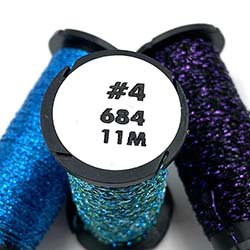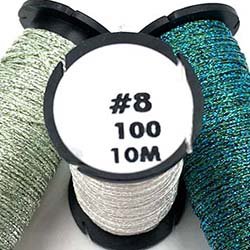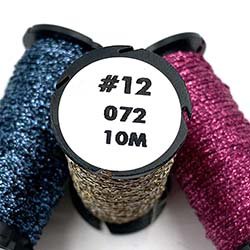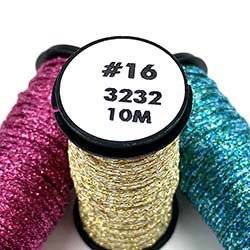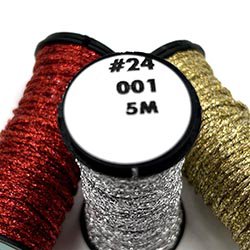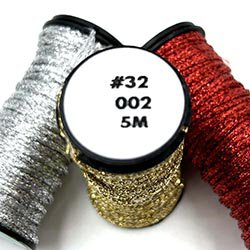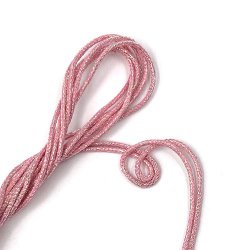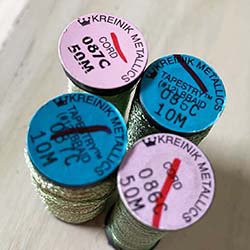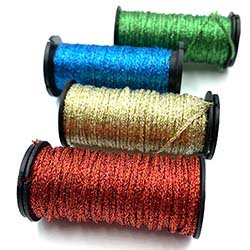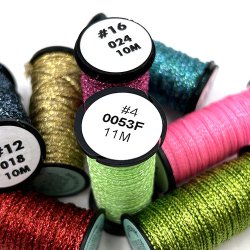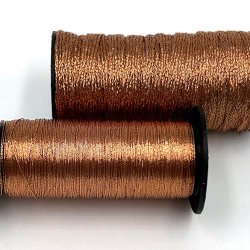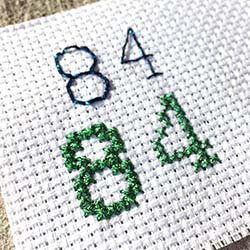Braids
The Braid number indicates size; the smaller the number, the smaller the thread. Very Fine #4 Braid is the thinnest, and Heavy #32 Braid is the thickest. They are used straight off the reel as is, not separated or plied. Meant to be used as a single strand; if you need thicker coverage, go up a Braid size. Fine #8 Braid, for instance, is twice as thick as Very Fine #4 Braid. Medium #16 Braid is twice as thick as Fine #8 Braid.
-
Discontinued Kreinik metallic colors
We hate to discontinue any thread color, but sometimes it is required due to manufacturing problems (for example, if we can't get the raw material to transform it into your favorite Kreinik threads). You will find the list of discontinued colors below. If you have these in your stash, we recommend putting a mark on the label to indicate a discontinued color.
Important tips for stitchers who buy thread stashes on Ebay, at estate sales, and Goodwill/Salvation Army stores:
- The thread dye lot most likely has changed. Mark those threads so you know and won't get caught running out mid project.
- Some of those threads may be discontinued. Google search or contact the manufacturer to double check before you use them in a project (and end up needing more).
Discontinued Kreinik colors and substitution suggestions:
NM means no close match
- 003C Red Cord = 003 Red
- 005C Black Cord = 005 Black
- 007C Pink Cord = 007 Pink
- 008C Green Cord = 008 Green
- 011C Nickel Cord = 010HL Steel Grey
- 012C Purple Cord = 012 Purple
- 022L = 052HL Bronze
- 026L = 026 Amethyst
- 027L Orangeruptis = 027 Orange
- 029L = 029 Turquoise
- 031L Berry Red = 153V Vintage Burgundy
- 032C Pearl Cord = 032 Pearl
- 034 Confetti = NM
- 041 Confetti Pink = 044 Confetti Blue
- 041C Confetti Pink Cord = 044 Confetti Blue
- 042 Confetti Fuchsia = NM
- 042L Optic Opal = NM
- 043 Confetti Green = NM
- 051C Sapphire Cord = 051HL Sapphire Hi Lustre
- 056F Blueberry = NM
- 057F Grape = NM
- 070 Mardi Gras = 5011 Elfin Green
- 080 Garnet in Miro Ice Chenille = Red is a bolder version
- 080C Garnet Cord = 080HL Garnet Hi Lustre
- 086C Fern = 4201 Sugar Cane
- 087C Meadow Grass = 089 Aspen
- 088C Lily Pond Cord = 4201 Sugar Cane
- 104C Colonial Gold Cord = 102C Vatican Gold Cord
- 195 Sunburst = 095 Starburst
- 202C Indigo Cord = 018 Navy
- 225C Slate Cord = 4204 Storm Cloud
- 2094HL Heather Hi Lustre = NM
- 235 Red Ember = 307 Deep Coral
- 271 Plum = 3223 Ametrine
- 664 Magenta Blue = NM
- 3240 Opal = 095 Starburst
- 3508 Rhumba Green = 829 Mint Julep
- 3509 Cha Cha Verde = 008HL Green Hi Lustre
- 3540 Bolero Black = 005 Black
- 393 Silver Night = 622 Wedgewood Blue
- 4001 Green Tea = 4201 Sugar Cane
- 4002 Spiced Chai = 4202 Dusky Meadow
- 4003 Ginseng Gold = 4203 Cattail
- 4004 Earl Grey = 4204 Storm Cloud
- 4005 Sugar Cube = 102 Vatican Gold
- 4006 Rosehip = 007 Pink
- 4639 Light Aqua = 3214 Blue Zircon
- 5002 Pixiedust = NM
- 5004 Love Potion = 024L Fiery Fuchsia
- 5007 Brocade = 5006 Ore
- 5008 Leprechaun = 009 Emerald
- 5500 PInk Lemonade - 5700 Cotton Candy
- 5525 Lemon = 5725 Lollipop Lemon
- 5530 Rosemary Green = 4201 Sugar Cane
- 9132 Lemongrass = 5725 Lollipop Lemon
- 9300 Orchid = NM (closest pastel is slightly darker 093 Star Mauve)
- Easter Grass in 1/8" Ribbon size (Easter Grass still available in 1/16" and 1/32")
- Marine Blue in Micro Ice Chenille = NM
- Petite/Facets 012 = Petite/Facets 026
- Petite/Facets 029L = NM
-
Kreinik Braids: Uses and Care
Applications
Uses depend on the thickness of the Braid but include: blackwork, cosplay, crazy quilting, crewel, crochet, cross stitch/counted thread, doll making, fly fishing, hardanger, kids crafts, knitting (by hand), lace making, machine embroidery/bobbin work, machine embroidery/couching, miniatures, needlepoint, plastic canvas, punch embroidery, quilting, ribbon embroidery, serging, silk gauze/Polysil, smocking, stumpwork, tatting, weaving.
Braids are available in several metallic types or effects: Basic (no letter in the color number), Hi lustre (HL), Glow-in-the-dark (F), Vintage (V), Holographic (L), and Corded (C).
Material Content
100% polyester (holographic colors), 65% polyester/35% rayon (regular colors), 62% polyester/38% nylon (hi lustre colors), 64% polyester/36% nylon (vintage colors), 80% polyester/20% nylon (glow in the dark colors)
Care
Kreinik Braids are hand or machine washable and dry cleanable. Cool water is recommended. Do not use bleach. They can also be tumble-dried on low setting. When ironing a finished piece containing Kreinik Braids, do not iron directly on the thread; use a cloth, and do not use steam.
Hand Embroidery
- Kreinik Braids are used alone rather than combined with another thread type in the needle.
- Use them to recreate the color and texture of nature and life, such as glistening snow, luminescent butterflies, glowing moons and stars, polished black leather shoes, shimmering fish or sea life, and more.
- You can also use their light-reflecting properties to create mood in a design; imagine the radiant stardust of an angel, the magical shimmer of a mermaid, or the crystalline coating of a winter's snowfall.
- Of course, you can also use the metallic braids just to bring sparkle, depth, texture and visual interest to any project, whether it is worked in crochet, cross stitch, canvas work, crewel, or embroidery.
- Don't be afraid of adding a light source in a design and replacing a cotton or wool thread for a metallic thread; the effect of combining different thread textures can be more visually exciting than a design worked in a single thread type. With these braids, your creative possibilities are endless.
Machine Embroidery
- Kreinik Braids offer colorful, textured embellishment options, but are best used in bobbin work. The thicker Braids can be couched; to make it easiest, get a Couching Foot for your machine.
- Experiment with tension settings, needles, machine feet and thread set-ups until you get a combination that works for your machine and fabric.
- Using decorative threads with a sewing machine may take a little extra time, but the colors and textures won't disappoint you in the finished project. They can create award-winning, memory-making, dynamic visual effects.
Weaving
- You can use Kreinik Braids in the warp or weft.
- They add gorgeous texture and light.
- The smaller the Braid number, the lighter weight the thread: #4 and #8 are lace/fingering weight, #12 is superfine/fingering, #16 is superfine/baby, #24 Braid is fine/light, #32 Braid is light.
- Kreinik metallics don't felt, and are inelastic compared to some other types of yarns, so for best results, we recommend testing the threads with the weaving yarns you plan to use before beginning your project.
- You may want to experiment with looser sett to vary drapability. Basic colors (no letter in the color number) tend to be softer.
- Weight/Yardage: Kreinik metallic yarns are not measured in terms of weight like wool or cotton yarns are, so measure by yard or meter.
- For weaving we suggest purchasing cones rather than small spools.
- SETT info available by request.
-
Braid stitching tips
Which size Braid do you need?
Choose the size of Braid based on the size of your needlepoint canvas, cross stitch fabric, or embroidery fabric, or your desired stitches. Couching stitches, for example, can use any size Braid. Cross stitches, on the other hand, need smaller Braids for 14-count, 16-count, 18-count etc. Needlepoint can be done using many stitches, so you may want to vary Braid size based on your stitch selection.
What do the numbers mean?
The numbers indicate how many strands of the raw materials are used to make the size; for you, the most important thing is the smaller the number in the Braid name, the smaller the thread. So Very Fine #4 Braid is our thinnest metallic, Fine #8 Braid is twice the size of #4 Braid, Medium #16 Braid is twice the size of #8 Braid etc. Heavy #32 Braid is the thickest.
What do the letters in the color numbers mean?
Kreinik Braids come in different metallic finishes, designed to give different effects and looks to a design. HL in the color number means hi lustre, V means vintage or antiqued, L means holographic, F means fluorescent, C means corded. These special effect colors may be a bit thicker and stiffer, so experiment with going down a Braid size if needed.
What is the material content?
It depends on the color:
- 100% polyester (holographic colors)
- 65% polyester/35% rayon (regular colors)
- 62% polyester/38% nylon (hi lustre colors)
- 64% polyester/36% nylon (vintage colors)
- 80% polyester/20% nylon (glow in the dark colors)
Top tips
Have fun with Kreinik Braids, adding light, color, texture and dimension to a design. They make things more visually exciting, realistic or whimsical. Here are more tips on using Kreinik Braids in handwork:
- Use short lengths of thread-about 45cm (18 inches) or less-to avoid excessive abrasion when pulling the thread through the ground fabric or canvas. The more we pull a strand through fabric or canvas, the more 'wear' it causes on the thread. Using shorter lengths will maintain the quality of the thread, plus reduce tangling as shorter lengths are easier to control (less knotting!).
- Needle selection is one of the most important decisions in getting a thread to behave. If you are stitching on fabric, use a needle large enough to 'open' the hole in the fabric sufficiently and allow the thread to go through more easily. A too-small needle will cause a thread to fray, knot, tangle. Make sure your needle is clean and free from burrs, and go up a needle size to help the thread move through the fabric easily.
- For a quick-and-easy, take-anywhere threading technique, cut a small strip of paper and fold in half. Place the fold through the eye of the needle and open the two ends to insert the thread in between. Gently pull the paper through so the thread is brought with it

- You may wish to moisten the Braid with a slightly damp sponge to help relax the thread and thus reduce twisting and knotting.
- The way a needle is twisted during stitching, combined with the twist of the thread, can cause any thread to twist on itself. Stitch slowly for greater control, and let your needle hang frequently to let the thread untwist.
- Stitch using the 'stab' method rather than the 'hand sewing' method to reduce tangling, working your stitches in two movements: up vertically then down vertically through the fabric.
-
What is a Corded Braid?
If a Kreinik Braid or Ribbon color has the letter C in it—such as 002C, or 005C—that means it's a "corded Braid" or "braided Cord." This is a special kind of fiber that requires a little extra stitching care. Let's start with the core fiber...
Kreinik Cord is a single-strand thread that has a metallic covering tightly wrapped over a core (gimp). Imagine a very thin, wire-like metallic thread that is strong enough to be used in a sewing machine but thin enough to add a clean line to designs.

This Kreinik Cord is used to make Kreinik corded braids and corded ribbons. These heavier threads carry a "C" after the color number and have a nubby, real-metal appearance. Corded Braids are increasingly being used in place of real metal threads because they closely resemble them and are less costly.

Besides being an alternative to real-metal threads, corded braids are also used in a design when you want to add a nubby texture — such as the wheel on a locomotive. While basic metallic braids give a shiny finish, the nature of a corded braid makes it more subdued and texturized, thus opening up a world of design possibilities. Imagine using Kreinik Medium #16 Braid 002C Gold alongside Cord 002C Gold, for example; you will get two different textures from the same color.

Since the core fiber is a strong, wire-like thread, a corded braid can be slightly thicker or stiffer than a basic braid. So most corded braids are couched onto the surface of a design using a matching color of Kreinik Cord as the tacking thread. If you stitch in and out of a fabric with a corded braid (rather than couch it), then simply stitch carefully, slowly, and with a larger needle to open the hole in the canvas sufficiently.
Enjoy the corded braids when you are adding different textures to make your design look more realistic or exciting. They come in different braid sizes: Tapestry #12 Corded Braid colors are about .60mm thick, while Medium #16 Corded Braid colors are slightly thicker at .81mm thick. Choose the size that suits your chosen stitch and pattern.
-
How to calculate thread amount
For cross stitch or needlepoint
The following offers guidance for determining how much thread you may need to stitch your project. Knowing exactly how much thread you will need for a project is not an exact science. There are many factors that vary from project to project and stitcher to stitcher.
This info comes from stitchers who provided us with the information based on their projects. Stitching techniques and tension may vary from person to person, so you may want to stitch an inch or stitch a test area and calculate how much thread was required. Then use that measurement to guesstimate on your project area. We suggest adding an additional 10% to 20% to include a margin of error (variances in stitch techniques, whether you have to rip out, how much thread is used to start and stop, etc)
Keep in mind that specialty stitches take extra thread, so the comments below are only for Tent Stitch or the Cross Stitch.
- NEEDLEPOINT: The formula for yardage calculation for TENT STITCH is The square inches to be worked x 1.5 = thread yardage needed. That is based on using 1.5 yards to complete a 1” square. So, calculate the square inches of the area you are stitching and multiply it times 1.5 to get the amount of thread in yards that you need.
- CROSS STITCH: On 18 count Aida, it took 95 inches of Very Fine #4 Braid to stitch a 1-inch square.
- CROSS STITCH: On 18-count Aida, it took 98 inches of Fine #8 Braid to stitch a 1-inch square
- CROSS STITCH: On 14 count Aida, it took 75 inches of Very Fine #4 Braid to stitch a 1-inch square
- CROSS STITCH: On 14-count Aida, it took 78 inches of Fine #8 Braid to stitch a 1-inch square



